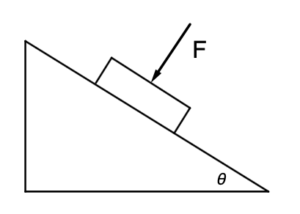| Step | Derivation/Formula | Reasoning |
|---|---|---|
| 1 | m = 110 \, \text{kg} | Total mass of the person and bicycle is the sum of their individual masses. |
| 2 | d = 7 \, \text{m} | Distance rolled down the hill before stopping. |
| 3 | \theta = 25^\circ | Angle of inclination of the hill. |
| 4 | g = 9.8 \, \text{m/s}^2 | Acceleration due to gravity. |
| 5 | \mu_k = 0.65 | Coefficient of kinetic friction. |
| 6 | \Delta PE = mgh = mgd \sin(\theta) | Calculate potential energy lost over the 7 m descent using the height change formula h = d \sin(\theta) . |
| 7 | h = 7 \sin(25^\circ) | Calculate the vertical distance descended. |
| 8 | \Delta PE = 110 \times 9.8 \times 7 \sin(25^\circ) | Substitute known values into the potential energy formula. |
| 9 | \Delta PE \approx 2793.24 \, \text{J} | Amount of energy needed to be transformed into friction, to bring the bike to a complete stop. |
| 9.5 | Calculate the maximum possible energy that friction can generate. | Use the W = Fd as shown below |
| 10 | f_k = \mu_k (mg \cos(\theta)) | Calculate the force of kinetic friction acting on the bicycle and rider while moving down the slope. |
| 11 | f_k = 0.65 \times (110 \times 9.8 \times \cos(25^\circ)) | Substitute into the force of friction formula. |
| 12 | f_k \approx 627.89 \, \text{N} | Calculating the force using approximate value of cosine function. |
| 13 | W = f_k \times d | Work done by friction is the product of the force of friction and the distance over which it acts. |
| 14 | W = 627.89 \times 7 | Substitute the values into the work formula. |
| 15 | W \approx 4395.23 \, \text{J} | Calculating the total work done by friction. |
| 16 | Conclusion | The work done by friction exceeds the energy needed to bring the bike to a complete halt. Only 2793.24 J of frictional energy is transformed from potential energy to bring to bike to rest. |
Phy can also check your working. Just snap a picture!
 A force F is used to hold a block of mass m on an incline as shown in the diagram above. The plane makes an angle of \theta with the horizontal and F is perpendicular to the plane. The coefficient of friction between the plane and the block is µ. What is the minimum force, F, necessary to keep the block at rest?
A force F is used to hold a block of mass m on an incline as shown in the diagram above. The plane makes an angle of \theta with the horizontal and F is perpendicular to the plane. The coefficient of friction between the plane and the block is µ. What is the minimum force, F, necessary to keep the block at rest?
A block of mass m is moving on a horizontal frictionless surface with a speed v_0 as it approaches a block of mass 2m which is at rest and has an ideal spring attached to one side.
When the two blocks collide, the spring is completely compressed and the two blocks momentarily move at the same speed, and then separate again, each continuing to move.
A car slides up a frictionless inclined plane. How does the normal force of the incline on the car compare with the weight of the car?
Two boxes are tied together by a string and are sitting at rest on a frictionless surface. Between the two boxes is a massless compressed spring. The string trying the two boxes is then cut and the spring expands, pushing the boxes apart. The box on the left has four times the mass of the box on the right.
Jill does twice as much work as Jack does and in half the time. Jill’s power output is
2793.24 Joules
By continuing you (1) agree to our Terms of Sale and Terms of Use and (2) consent to sharing your IP and browser information used by this site’s security protocols as outlined in our Privacy Policy.
| Kinematics | Forces |
|---|---|
| \Delta x = v_i t + \frac{1}{2} at^2 | F = ma |
| v = v_i + at | F_g = \frac{G m_1m_2}{r^2} |
| a = \frac{\Delta v}{\Delta t} | f = \mu N |
| R = \frac{v_i^2 \sin(2\theta)}{g} |
| Circular Motion | Energy |
|---|---|
| F_c = \frac{mv^2}{r} | KE = \frac{1}{2} mv^2 |
| a_c = \frac{v^2}{r} | PE = mgh |
| KE_i + PE_i = KE_f + PE_f |
| Momentum | Torque and Rotations |
|---|---|
| p = m v | \tau = r \cdot F \cdot \sin(\theta) |
| J = \Delta p | I = \sum mr^2 |
| p_i = p_f | L = I \cdot \omega |
| Simple Harmonic Motion |
|---|
| F = -k x |
| T = 2\pi \sqrt{\frac{l}{g}} |
| T = 2\pi \sqrt{\frac{m}{k}} |
| Constant | Description |
|---|---|
| g | Acceleration due to gravity, typically 9.8 , \text{m/s}^2 on Earth’s surface |
| G | Universal Gravitational Constant, 6.674 \times 10^{-11} , \text{N} \cdot \text{m}^2/\text{kg}^2 |
| \mu_k and \mu_s | Coefficients of kinetic (\mu_k) and static (\mu_s) friction, dimensionless. Static friction (\mu_s) is usually greater than kinetic friction (\mu_k) as it resists the start of motion. |
| k | Spring constant, in \text{N/m} |
| M_E = 5.972 \times 10^{24} , \text{kg} | Mass of the Earth |
| M_M = 7.348 \times 10^{22} , \text{kg} | Mass of the Moon |
| M_M = 1.989 \times 10^{30} , \text{kg} | Mass of the Sun |
| Variable | SI Unit |
|---|---|
| s (Displacement) | \text{meters (m)} |
| v (Velocity) | \text{meters per second (m/s)} |
| a (Acceleration) | \text{meters per second squared (m/s}^2\text{)} |
| t (Time) | \text{seconds (s)} |
| m (Mass) | \text{kilograms (kg)} |
| Variable | Derived SI Unit |
|---|---|
| F (Force) | \text{newtons (N)} |
| E, PE, KE (Energy, Potential Energy, Kinetic Energy) | \text{joules (J)} |
| P (Power) | \text{watts (W)} |
| p (Momentum) | \text{kilogram meters per second (kgm/s)} |
| \omega (Angular Velocity) | \text{radians per second (rad/s)} |
| \tau (Torque) | \text{newton meters (Nm)} |
| I (Moment of Inertia) | \text{kilogram meter squared (kgm}^2\text{)} |
| f (Frequency) | \text{hertz (Hz)} |
General Metric Conversion Chart
Example of using unit analysis: Convert 5 kilometers to millimeters.
Start with the given measurement: \text{5 km}
Use the conversion factors for kilometers to meters and meters to millimeters: \text{5 km} \times \frac{10^3 \, \text{m}}{1 \, \text{km}} \times \frac{10^3 \, \text{mm}}{1 \, \text{m}}
Perform the multiplication: \text{5 km} \times \frac{10^3 \, \text{m}}{1 \, \text{km}} \times \frac{10^3 \, \text{mm}}{1 \, \text{m}} = 5 \times 10^3 \times 10^3 \, \text{mm}
Simplify to get the final answer: \boxed{5 \times 10^6 \, \text{mm}}
Prefix | Symbol | Power of Ten | Equivalent |
|---|---|---|---|
Pico- | p | 10^{-12} | 0.000000000001 |
Nano- | n | 10^{-9} | 0.000000001 |
Micro- | µ | 10^{-6} | 0.000001 |
Milli- | m | 10^{-3} | 0.001 |
Centi- | c | 10^{-2} | 0.01 |
Deci- | d | 10^{-1} | 0.1 |
(Base unit) | – | 10^{0} | 1 |
Deca- or Deka- | da | 10^{1} | 10 |
Hecto- | h | 10^{2} | 100 |
Kilo- | k | 10^{3} | 1,000 |
Mega- | M | 10^{6} | 1,000,000 |
Giga- | G | 10^{9} | 1,000,000,000 |
Tera- | T | 10^{12} | 1,000,000,000,000 |
The most advanced version of Phy. Currently 50% off, for early supporters.
per month
Billed Monthly. Cancel Anytime.
Trial –> Phy Pro
A quick explanation
UBQ credits are specifically used to grade your FRQs and GQs.
You can still view questions and see answers without credits.
Submitting an answer counts as 1 attempt.
Seeing answer or explanation counts as a failed attempt.
Lastly, check your average score, across every attempt, in the top left.
MCQs are 1 point each. GQs are 1 point. FRQs will state points for each part.
Phy can give partial credit for GQs & FRQs.
Phy sees everything.
It customizes responses, explanations, and feedback based on what you struggle with. Try your best on every question!
Understand you mistakes quicker.

For GQs and FRQs, Phy provides brief feedback as to how you can improve your answer.
Aim to increase your understadning and average score with every attempt!
10 Free Credits To Get You Started
*Phy Pro members get unlimited credits

By continuing you agree to nerd-notes.com Terms of Service, Privacy Policy, and our usage of user data.